Training in 2024 is just as important as ever. How do you integrate training, education and continued learning with today’s busy contractor? Power Points, sales pitches and doughnuts. Tried and true methods of training gone by, that’s for sure. But what does today’s training look like, especially in the purview of the younger generation of Read more
Caleffi
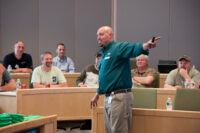
Training in 2024 is just as important as ever. How do you integrate training, education and continued learning with today’s busy contractor?
Power Points, sales pitches and doughnuts. Tried and true methods of training gone by, that’s for sure. But what does today’s training look like, especially in the purview of the younger generation of contractors that digests information in 90 seconds or less?
“What was that? Sorry, I was looking at my phone,” jokes Max Rohr, Director, Education and Technical Marketing, Caleffi. “Five years ago, a three-minute-long video was a good option, now it will seem long if it is over that 90-second threshold. Ideally, you get to the point in the first five seconds and work the explanation back from there. Like showing the cake and then going back to bowls of ingredients.”
According to, Dave Holdorf, Residential Trainer & Rep Training Manager—Eastern Region, Taco Comfort Solutions, it’s a challenge. “We’ve found that it helps to bring different instructors in for specific segments of the training. Each instructor brings their own perspective; even hearing a different voice in the room makes for a more compelling presentation. Every facet of our training is now geared to maintain the attention of participants. We also make sure to schedule breaks so that the attendees can attend to business, or need at home. By creating the curriculum with attendees in mind, their focus remains with the topic in front of them.”
Nevertheless, the training department at Taco has always looked at training not from a product view but from an application perspective, giving attendees the information they need to do their job better, and to give their customers the comfort they deserve. “We use real world experiences to solve real world problems with personal experiences and a bit of humor—as you know, John, it ain’t worth doing if you’re not having fun as well,” says Holdorf.

Caleffi’s Bob “Hot Rod” Rohr brings his props and his wealth of experience and knowledge to trainings.
But what about those PowerPoints and doughnuts? “Every learning style is different, so you have to be adaptable. If you see the audience tuning out a PowerPoint, stop and grab a product to bring to an attendee and talk about a case study that is related instead,” says Rohr.
In addition, everything falls apart for a trainer if the audience gets the impression they are overpromising, adds Rohr. For example, “Honesty is something Hot Rod is specifically good at in contractor training sessions. As a former installer, he always has tips for getting the job done and workarounds that are really tangible,” says Rohr.
The New Normal?
The Covid pandemic saw what we thought was going to be a new normal with virtual training, but what we are now seeing is the importance, and return, of in-person training.
This past year Taco saw a huge jump of in-person training, on the road as well as at Taco HQ in Rhode Island. So much so that the company had to dramatically increase the number of sessions back in Rhode Island to accommodate. “However, that does not mean to diminish the virtual training, Taco Tuesday and Taco After Dark webinars are still posting a large number of attendees that are hungry for information in bite size chunks, not as large as when we all locked down at home, but still popular,” says Holdorf.
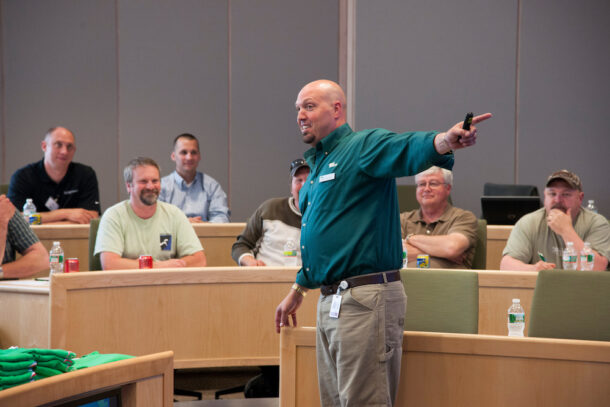
Taco’s Holdorf conducts a training at the Cranston, R.I. HQ.
Nonetheless, “when we’re online, we know it’s so easy to stray off to the next shiny thing online, so to keep attendees engaged, we encourage two-way communications. If participants have questions, we want them to ask immediately,” continues Holdorf.
In fact, Holdorf says that people who attend Taco’s webinars typically take it to the next level and seek live training. A combination of both virtual and live training can help attendees dial in on what they want to learn—or perhaps didn’t initially develop a full understanding of what it is they most needed to know. “These options allow them to fine-tune their training experience to make them as good as they want to be. And, ideally, we help them raise the bar. We routinely heard from trade pros who came to us for a better understanding of a single application or concept, and through that experience come away with an energized desire for much more,” says Holdorf.
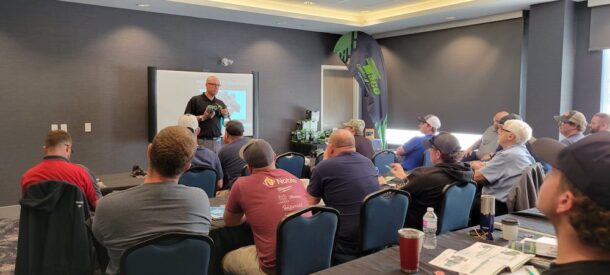
In 2023, Caleffi performed almost a 50/50 mix of in-person and virtual. Contractors like hands-on training, says Rohr, so it is good to be back on job sites for that type of interaction. And, engineers didn’t all go back to the office after COVID. “Many of the engineering sessions we do are virtual because that firm may be scattered all over the region. You might catch 20 people in a virtual training, where only 10 of them are in the office that day,” says Rohr.
Know-It-Alls
What about those who are stubborn enough to think that they don’t need further education and training? “I love this question and see and hear it often in the industry,” says Ken Midgett, L.M.P, Plumbing, Marketing Director, Interplay Learning, and former Teacher and Apprenticeship Instructor, Lehigh Career & Technical Institute.
Those in skilled trades should embrace the concept of being “lifelong learners,” consistently expanding their knowledge in their current specialty and exploring related disciplines. Whether licensed or not, individuals in skilled trades should assess their goals, career paths and professional growth within their field. It’s common for some to reach a point where they feel adequately skilled and think further education is unnecessary. According to Midgett, this assumption is misleading for several reasons:
• For example, a residential plumber could benefit from learning about commercial plumbing, Med Gas, Backflow, Water Well work, Water Conditioning, HVAC, Electrical, etc. Diversifying skills not only enhances one’s expertise but also increases their marketability across various skill sets, intern boosting income and long-term employability.
• Despite advancements in safety measures within the construction industry, the misconception that skilled trades workers are immune to injuries persists. While the overall safety landscape has improved, life-changing injuries can still occur. In such unfortunate instances, if an individual can only rely on skills specific to their trade and lacks versatility, their career may face irreparable damage. Therefore, investing in ongoing training, education, and professional development becomes crucial for ensuring resilience in the workforce and mitigating the impact of unforeseen challenges. Repurposing skillsets may be challenging when there has been no prior skill or professional development planning before the injury event.
• The industry, codes, tools, and methods to do a task are constantly changing. Skilled trades workers need to educate themselves and stay on top of new developments. This is critical to the success of a technician and company.
In the end, it’s what ends up in the ol’ noggin as useful information that translates to the jobsite. “Students only retain a tiny amount of the information that you present to them, but they will remember their feelings about the trainer for a very long time,” says Rohr. “It is hard to know if a bigger win is when customers retain a piece of information you presented or if they remember that you seem like you know what you are talking about. “If they trust that you did a good job, that memory will stay with them for a career, potentially.”
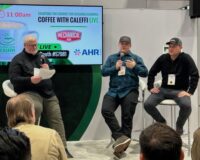
On the opening day of the AHR Expo in Chicago—Monday, January 22—the crew from Mechanical Hub was fully immersed in the very first Coffee with Caleffi Live from the Caleffi booth. There, emcees John Mesenbrink and Tim talked with industry powerhouses John “Siggy” Siegenthaler, Bob “hot Rod” Rohr, Eric Aune and Andy Mickelson about the Read more
On the opening day of the AHR Expo in Chicago—Monday, January 22—the crew from Mechanical Hub was fully immersed in the very first Coffee with Caleffi Live from the Caleffi booth. There, emcees John Mesenbrink and Tim talked with industry powerhouses John “Siggy” Siegenthaler, Bob “hot Rod” Rohr, Eric Aune and Andy Mickelson about the lifelong learning in the trades.

From l to r: Emcee John Mesenbrink, John Siegenthaler and Bob Rohr
In the first half of the presentation, the hosts asked “Siggy” and “Hot Rod” where they go to find the resources they need to keep up in today’s contracting world. Having forgotten more than most have learned in a lifetime, where do these legends go to learn?

From l to r: Emcee John Mesenbrink, Eric Aune and Andy Mickelson
Part two featured Eric Aune and Andy Mickelson as they shared their point of view from the eyes of a business owner and working contractor, and discussed the importance of social media and its impact on learning.
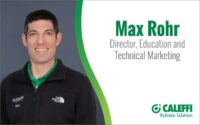
Max Rohr has been appointed Director of Education and Technical Marketing, a newly created function within Caleffi North America, Inc. In this capacity, Rohr will lead the ideation, development and execution of Caleffi’s training platforms including the idronics™ design journal series, Coffee with Caleffi™ monthly webinars, Caleffi Academy field training and Ask Caleffi blog and podcasts. He Read more
Max Rohr has been appointed Director of Education and Technical Marketing, a newly created function within Caleffi North America, Inc. In this capacity, Rohr will lead the ideation, development and execution of Caleffi’s training platforms including the idronics™ design journal series, Coffee with Caleffi™ monthly webinars, Caleffi Academy field training and Ask Caleffi blog and podcasts. He will also ensure technical data, designer tools and installer information remains firmly integrated within the mainstream market communications of the company.
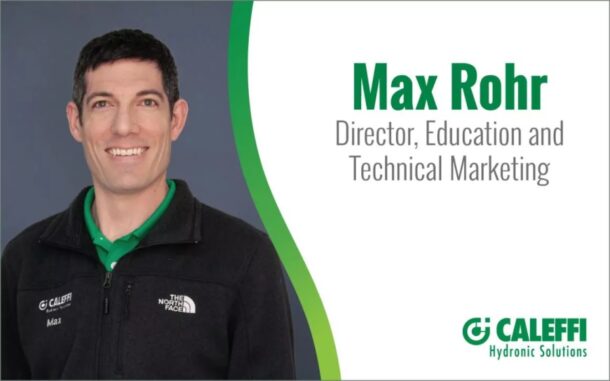
Stated CEO Mark Olson, “A cornerstone to Caleffi success from the start has been our Excellence in Education. The size and complexity of our programs and ambition to continue leading in compelling educational approaches justifies a singular focus”. Adds VP of Sales Roger Corrente, “Our customers often express how valuable our training is. Max is now integral to continuing the creative education initiatives that help our sales and rep teams succeed”.
After college Rohr interned at Caleffi headquarters in Italy for a year. “It was an incredible opportunity to learn about manufacturing, shoulder-to-shoulder with a team that is so dedicated to quality control. Caleffi is committed to long-term employee development and that always stuck with me,” Rohr reminisced.
Before rejoining Caleffi in 2020, Rohr spent five years at REHAU as Marketing and Academy Manager (Leesburg, Va.) and five years in outside sales with Shamrock Sales Inc. (Denver) and broadening his overall channel experience. He holds a bachelor’s degree in behavioral science and health from the University of Utah.
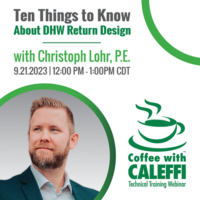
Domestic hot water (DHW) design is critical to optimize energy efficiency, while reducing water waste. Guest host Christoph Lohr, P.E. will detail the policies, standards, and credentials that can help designers and installers navigate the waters. He will discuss these ten critical issues related to DHW design: → Definition: Recirculating vs. Circulating → Automatic Balancing Valves vs Read more
Domestic hot water (DHW) design is critical to optimize energy efficiency, while reducing water waste. Guest host Christoph Lohr, P.E. will detail the policies, standards, and credentials that can help designers and installers navigate the waters.
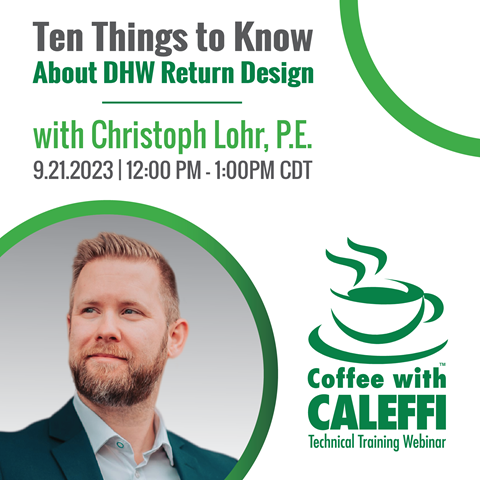
He will discuss these ten critical issues related to DHW design:
→ Definition: Recirculating vs. Circulating
→ Automatic Balancing Valves vs. Manual Balancing Valves
→ ASSE/IAPMO IGC Standard 368 for thermostatic balancing valves and IAPMO/ASSE/ANSI 1115-202x for Automatic Balancing Valves
→ Digital Master Mixing Valve Standard IGC 384 (IAPMO/ASSE/ANSI 1118-202x)
→ Right Sizing Hot Water Supply Systems (Water Demand Calculator)
→ Right Sizing Hot Water Return Systems (Hardy Cross Methodology)
→ ASSE 12000 Series Credential
→ Testing and Balancing/Commissioning of hot water systems
→ ASPE 99 Thermal Disinfection Standard Development
→ Hot Water Return Pump: UPC Code Update
Christoph is IAPMO’s Vice President of Technical Services and Research. As part of his duties he provides industry leadership through participation in strategic industry initiatives, and provides technical support to all IAPMO’s business units as needed. Christoph has over a decade of experience in designing plumbing systems and has a reputation as a results-oriented expert, particularly in the realm of balancing waterborne pathogen prevention and water sustainability. He is a distinguished graduate from the Virginia Military Institute, with a Bachelor of Science in Mechanical Engineering.
Coffee with Caleffi technical training webinars are free and intended for contractors, designers and wholesalers. A Certificate of Attendance is emailed to attendees following the webinar for continuing education consideration. Want to join us? Simply register today.

Can a hydronic system effectively – and efficiently – provide heating, cooling, domestic hot water AND heat recovery ventilation in a residential home? John Siegenthaler, P.E., a favorite to the webinar series, will discuss design details, challenges and lessons learned from a from a recent project profile of a modern hybrid approach utilizing an air-to-water heat Read more
Can a hydronic system effectively – and efficiently – provide heating, cooling, domestic hot water AND heat recovery ventilation in a residential home? John Siegenthaler, P.E., a favorite to the webinar series, will discuss design details, challenges and lessons learned from a from a recent project profile of a modern hybrid approach utilizing an air-to-water heat pump system that checks all of the boxes during this 90-minute extended edition.
You’ll learn:
→ Back-up heating. When is it necessary?
→ Can a single 44 watt circulator supply all space heating flow for a 2,300 square foot house?
→ Does chilled water cooling and heat recovery ventilation require separate duct systems?
→ Can panel radiators operate at supply water temperature below 100 ºF on design days?
→ Where does an “extended manifold” piping system make sense?
→ How are 3-way diverter valves applied in air-to-water heat pump systems?
→ What are the advantages of multi-zone heating combined with single-zone cooling?
Siegenthaler is a seasoned industry leader and passionate teacher, eager to share his over 40 years’ experience in the understanding and proper application of water-based engineering principles with our audience. He is the principal of Appropriate Designs and a regular contributor to industry publications.
Coffee with Caleffi technical training webinars are free and intended for contractors, designers and wholesalers. A Certificate of Attendance is emailed to attendees following the webinar for continuing education consideration. Want to join us? Simply register today.
